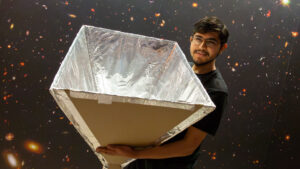Ritwik Sharma
Aerospace engineering
Hometown: Fremont, California, United States
Graduation date: Spring 2024
GCSP research stipend | Spring 2024
Design and Construction of a Wayfinding Method for the Completely Hackable Amateur Radio Telescope
The Completely Hackable Amateur Radio Telescope (CHART) is an outreach tool designed by the Low-Frequency Cosmology Lab to teach K-12 students about radio astronomy and its performance. Currently, the CHART cannot identify the direction it points in, making it harder for students to use. The CHART wayfinder is designed to solve this problem by telling the observer where the radio horn is pointing in altazimuth, galactic, and RA/Dec coordinates. It is designed to be a standalone project that any student could build themselves.
Mentor: Daniel C. Jacobs
Featured project | Spring 2024

Aerospace engineering sophomore Ritwik Sharma has been fascinated by rockets and aircraft since he was a child. The GCSP student is working on a cross-disciplinary project with Daniel C. Jacobs, an assistant professor in the ASU School of Earth and Space Exploration, to share his passion for space. His work, funded by the GCSP research stipend opportunity, involves developing a wayfinding method for the Completely Hackable Amateur Radio Telescope, known as CHART, an inexpensive and simple way to use radio waves to see features in outer space not visible to the human eye. His work aims to make the system more accessible for individuals and K-12 classroom instruction.
What made you want to get involved in this program? Why did you choose the project you’re working on?
I wanted to get involved with the GCSP research stipend because it felt much more applicable to my situation than FURI or MORE. My lab, the Low Frequency Cosmology Lab, is affiliated with the School of Earth and Space Exploration, which meant that I would be unable to get funding for a project through FURI. The GCSP research stipend, meanwhile, is open to all students participating in the Grand Challenges Scholars Program, so I knew that this program was right for me.
I specifically chose this project because I have had a strong interest in amateur astronomy since elementary school, as well as an interest in amateur radio.
How will your research project impact the world?
The guidance system I am designing for CHART will give K-12 students a way to understand how astronomers observe different parts of the universe with radio telescopes. This will improve their understanding of astronomy as a field by teaching them how astronomers locate objects in the sky, and why they have to rely on coordinates as opposed to general directions. Since the Earth is constantly revolving around the sun, our frame of reference is constantly changing, which makes coordinate systems like right ascension and declination and galactic an important part of the subject because they make tracking objects like galaxies and nebulae easier.
How do you see this experience helping with your career or advanced degree goals?
I plan to pursue a doctorate after I graduate from ASU, and I see this experience helping me by showing my future supervisors that I am capable of pursuing a project on my own, under the instruction of a mentor. This arrangement is common in graduate school where students work under the direction of their advisor on projects like their theses, dissertations or other items necessary to complete their doctoral or master’s degree. By showing my ability to work efficiently on a project like this, I can also show my future thesis advisor that I will be perfectly capable of completing something like a doctoral thesis, which will give me an advantage over other applicants.
What is the best advice you’ve gotten from your faculty mentor?
Some of the best advice that I have gotten from my mentor is to create a document to put all your ideas in for a project. Taking down notes on the approaches that you take and explaining why you took those approaches is really helpful because you can use those notes to explain your project to other people who are not as knowledgeable about your field. At the same time, taking notes can also improve your own understanding of your procedure by forcing you to think about whether or not you are approaching the project in the most efficient way possible.
Why should other students get involved in GCSP and research?
Other students should get involved in this program because of how valuable the experience can be to your resume. A lot of companies like seeing students who have completed projects during their time in college, and the GCSP research stipend is a good way to do that. While senior capstone projects also fill the same niche, this program is special because it gives students a way to learn more about how research works at a university like ASU in ways that a capstone project wouldn’t tell you. Even if you don’t want to pursue a graduate degree, having a fully funded project under your belt is always a plus no matter where you go after college.

